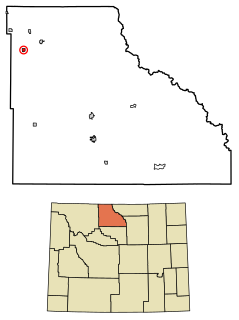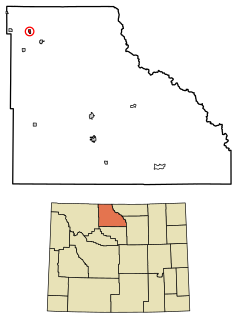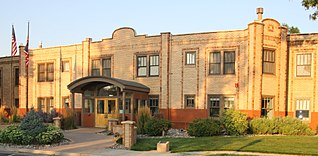
Basin is a town in, and the county seat of, Big Horn County, Wyoming, United States. The population was 1,285 at the 2010 census. The community is located near the center of the Bighorn Basin with the Big Horn River east of the town. Basin's post office, built in 1919, is listed on the National Register of Historic Places.

Byron is a town in Big Horn County, Wyoming, United States. The population was 593 at the 2010 census.

Cowley is a town in Big Horn County, Wyoming, United States. The population was 655 at the 2010 census. In 2019 the US Census Bureau put that figure at 623.

Natrona County High School (NCHS) is a public secondary school located in Casper, Wyoming, United States. It serves Natrona County School District #1, which encompasses all of Natrona County, Wyoming.

Rocky Mountain High School (RMHS) is a public high school in Cowley, Wyoming, United States. It covers grades 9 through 12, and is part of Big Horn County School District 1. RMHS serves the cities of Byron, Cowley, Deaver, and Frannie. The school mascot is the Grizzly Bear. In 2010 the Middle School and High School were combined into a 6-12 school in a new building in Cowley.
Big Horn County School District #1 is a public school district based in Cowley, Wyoming, United States. The Superintendent is Ben Smith. The district was consolidated in the 1980s from smaller districts in Burlington, Byron, Cowley, Deaver-Frannie.

The Bridger Trail, also known as the Bridger Road and Bridger Immigrant Road, was an overland route connecting the Oregon Trail to the gold fields of Montana. Gold was discovered in Virginia City, Montana in 1863, prompting settlers and prospectors to find a trail to travel from central Wyoming to Montana. In 1863, John Bozeman and John Jacobs scouted the Bozeman Trail, which was a direct route to the Montana gold fields through the Powder River Country. At the time the region was controlled by the Sioux, Cheyenne and Arapaho, who stepped up their raids in response to the stream of settlers along the trail.

The Wayne State University historic district consists of three buildings on 4735-4841 Cass Avenue in Midtown Detroit, Michigan: the Mackenzie House, Hilberry Theatre, and Old Main, all on the campus of Wayne State University. The buildings were designated a Michigan State Historic Site in 1957 and listed on the National Register of Historic Places in 1978.

St. John's Episcopal Church and Rectory form a complex of log structures in Jackson, Wyoming. The rectory was built first: in 1911 it was a hostel and community center under the supervision of Episcopal Bishop Nathaniel Thomas. Church services were held there until 1916, when the church was built. The church and hostel are among the largest log structures in Jackson Hole.

The Highlands Historic District in Grand Teton National Park is a former private inholding within the park boundary. The inholding began as a 1914 homestead belonging to Harry and Elizabeth Sensenbach, who began in the 1920s to supplement their income by catering to automobile-borne tourists. In 1946 the property was purchased by Charles Byron, Jeanne Jenkins and Gloria Jenkins Wardell, who expanded the accommodations by one or two cabins a year in a U-shaped layout around a central lodge. The lodge and cabins are constructed in a rustic log style, considered compatible with park architecture. The Highlands was neither an auto camp, which encouraged short stays, nor a dude ranch, which provided ranch-style activities. The Highlands encouraged stays of moderate length, providing a variety of relatively sedentary amenities. It was the last private-accommodation camp to be built in the park before the Mission 66 program created concessioner-operated facilities on public lands.

The Yellowstone Main Post Office in Yellowstone National Park was built in Mammoth Hot Springs as part of a facilities improvement program by the United States Post Office Department. The post office in Yellowstone was nominated to the National Register of Historic Places as part of a thematic study comprising twelve Wyoming post offices built to standardized USPO plans in the early twentieth century. The Yellowstone facility is an understated classical structure with a low hipped roof and rounded dormers that uses a plan and a basic design vocabulary similar to that used in other post offices in the program. It is somewhat at odds with the prevailing design theme expressed in other buildings in the former Fort Yellowstone district.

The T E Ranch Headquarters, near Cody, Wyoming, is a log ranch house that belonged to buffalo hunter and entertainer Buffalo Bill Cody (1846–1917). The house may have originally been built by homesteader Bob Burns prior to 1895, when Cody acquired the ranch. Cody expanded the ranch to about eight thousand acres (32 km²), using the T E brand for his thousand head of cattle.

The Lower Shell School House is located in an isolated portion of Big Horn County, Wyoming on a bluff near Shell Creek. The one-room schoolhouse was built in 1903, and was one of the first buildings in the area that did not use log construction. The school functioned as a church and Sunday school, and as a community meeting place. It was used as a school until the 1950s, and as a community meeting house until the 1970s.

The Callaghan Apartments, also known as the Plaza Apartments and Hotel and the Plaza Hotel, was erected in 1918 in Hot Springs State Park in Thermopolis, Wyoming. It was at one time one of six hotels catering to tourists using the Big Spring of Thermopolis, a hot spring reputed to possess curative properties. The hotel was erected by bricklayer James Callaghan, who obtained a 98-year lease on the site commencing on January 1, 1918. Callaghan made his own bricks in a kiln he built on the site, completing the Callaghan Apartments in June 1918. He employed several nurses and a masseur for his guests. In 1921 Callaghan sold the property to Dr. P.W. Metz who renamed it The Plaza.

There are 69 properties listed on the National Register of Historic Places in Albany, New York, United States. Six are additionally designated as National Historic Landmarks (NHLs), the most of any city in the state after New York City. Another 14 are historic districts, for which 20 of the listings are also contributing properties. Two properties, both buildings, that had been listed in the past but have since been demolished have been delisted; one building that is also no longer extant remains listed.

The Sundance School, also known as Old Stoney, was built in 1923 in Sundance, Wyoming to serve both the elementary and the high school students of Crook County School District #1. The two-story sandstone building is one of the largest buildings in Sundance. It served the community as a school until 1971.

The Daniel School was built in Daniel, Wyoming by contractor A.F. Atwood in 1920. The rural school served Daniel and its surrounding area, replacing improvised school facilities. In 1939, the Daniel district was consolidated, and students were bused to Pinedale for classes. Following consolidation, the Daniel School stood empty until the Daniel Homemaker Club acquired and renovated the building. It is a representative of a typical one-room schoolhouse from the early 20th century, and it has been the object of field trips by classes seeking to experience the historical learning environment.

Link & Haire was a prolific architectural firm in Montana, formally established on January 1, 1906. It designed a number of buildings that are listed on the National Register of Historic Places.

The EJZ Bridge over Shoshone River is a Warren pony truss bridge located near Lovell, Wyoming, which carries Big Horn County Road CN9-111 across the Shoshone River. Contractors McGuire and Blakeslee built the bridge from 1925 to 1926 using a design by the Wyoming Highway Department. The 389-foot-6-inch (118.72 m) bridge has four spans, the second-most of any truss bridge in Wyoming.

The American Legion Hall, Post 32 is a prominent social center in Greybull, Wyoming. Built in 1922 as a temporary church, it became an American Legion hall in 1935. Used as overflow space by nearby schools, it serves a diverse range of functions in the community.


















